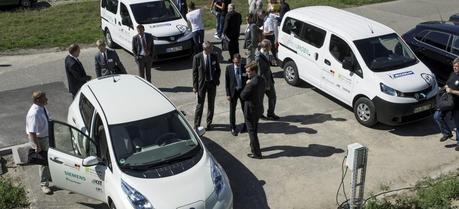 On the road since spring: data from commuter and business trips are used for further development. (Photo: Markus Breig)
On the road since spring: data from commuter and business trips are used for further development. (Photo: Markus Breig)The first results of the RheinMobil electric mobility project were presented this week by the project partners Michelin, Siemens, Karlsruhe Institute of Technology (KIT), and the Fraunhofer Institute for Systems and Innovation Research ISI. Based on business and commuter trips, the RheinMobil project aims at demonstrating that certain use profiles allow for an economically efficient operation of electric vehicles.
Since May, commuters from the Alsace region have used electric vehicles for their trips to the Karlsruhe Michelin factory. In parallel, Siemens employees have used electric vehicles for business trips between the Siemens plants at Karlsruhe and Haguenau. In total, distances of up to 360 km are covered daily. “We have now traveled about 24,000 km with our electric vehicles and collected many data that confirm our assumptions: So far, our RheinMobil vehicles have emitted about 2 t of CO2 less. Extrapolated to one year, emission reduction will presumably amount to nearly 4 t compared to conventional vehicles,” Dr. Olaf Wollersheim from KIT’s project management staff says. Technical maturity is comparable with that of conventional vehicles. “We see that commuting traffic is highly suited for the operation of electric vehicles: High mileages can be reached even with few charging stations and without any regional charging infrastructure,” says Dr. Kevin Stella, who coordinates the project together with Wollersheim. As the individual distances covered vary between 60 and 80 km, the limited range of electric vehicles is no obstacle. Moreover, commuting traffic is characterized by long times of non-use. Hence, no undesired waiting times occur.
According to the data obtained so far, annual mileages of nearly 40,000 km are possible. However, RheinMobil wishes to increase the utilization rate, which will be tested in the next phase of the project. The partners assume that high a utilization rate and quick charging are the prerequisites of economic efficiency. “In tests with higher utilization rates, we will study quick charging within 30 minutes and its influence on battery performance,” Stella points out. These tests will be based above all on the know-how about lithium-ion technology obtained under KIT’s Competence E project.
In the course of the project, quick charging shall be enhanced. 3000 quick charging processes per year are envisaged. At Michelin, staff from three shifts will use the same vehicle. This will be necessary, as the vehicles are not yet operated in an economically efficient manner, although about 15% of the energy used is recovered during braking, as a result of which the possible range of the vehicles can be increased.
Currently, two vehicles with seven persons each are operated by Michelin. The daily mileage amounts to about 320 km. “This project excellently fits to our company culture and in particular to our “performance and responsibility” charter. Here, we can combine our values “respect of the environment” and “promoting innovation” in an excellent way,” explains Christian Metzger, manager of the Michelin plant in Karlsruhe. “And if we want to have one million electric vehicles on the roads by 2020, as planned by the federal government, we cannot wait for someone to start.”
“We want to make our staff experience electric mobility and build up environmental awareness,” emphasizes Hans-Georg Kumpfmüller, director of the Siemens plant in Karlsruhe. He adds that the vehicles are used quite often for business trips to the Siemens plant at Haguenau, France, which is about 70 km away. First users of the electric vehicles are highly satisfied with the driving comfort.
The motivation and expectations of the participants are analyzed by the Fraunhofer Institute for Systems and Innovation Research ISI. “According to first surveys, the people are motivated to participate in the project by curiosity, the low operation costs of the technology, and their environmental awareness,” says Professor Martin Wietschel. According to him, the limited range and offer of electric vehicles are the biggest obstacles to their wide use at the moment.
Dr. Veit Steinle, department head at the Federal Ministry of Transport, Building, and Urban Development (BMVBS), underlines: “The electric mobility showcase projects launched by the federal government are in full swing now. The trends and intermediate results gained from projects, such as RheinMobil, are rather impressive and should be used directly for the further development of electric mobility, in showcase projects and outside of them. The federal government funds pre-commercialization phase research relating to electric mobility with about EUR 1 billion. Of these, about 180 million Euros are invested in the electric mobility showcase projects in Baden-Württemberg, Bavaria/Saxony, Lower Saxony, and Berlin/Brandenburg. The Federal Ministry of Transport wishes to support electric mobility in an application-oriented and open manner, with demonstration projects in fleet and commercial traffic playing an important role. We assume that the ecological and economic reduction potentials are very high in these areas.”
The RheinMobil project is one of about 40 projects in the Baden-Württemberg “LivingLab BWe mobil” electric mobility showcase. It is funded with about 1 million Euros by the Federal Ministry of Transport, Building, and Urban Development (BMVBS) under the showcase program of the federal government. In April 2012, the federal government selected four regions in Germany as “electric mobility showcases”. In these regions, research and development of alternative drive trains are funded according to the decision made by German parliament. For the showcase program, the federation will provide funds in the total amount of EUR 180 million. In large-scale regional demonstration and pilot projects, electric mobility will be tested at the interface of energy system, vehicle, and traffic system.

